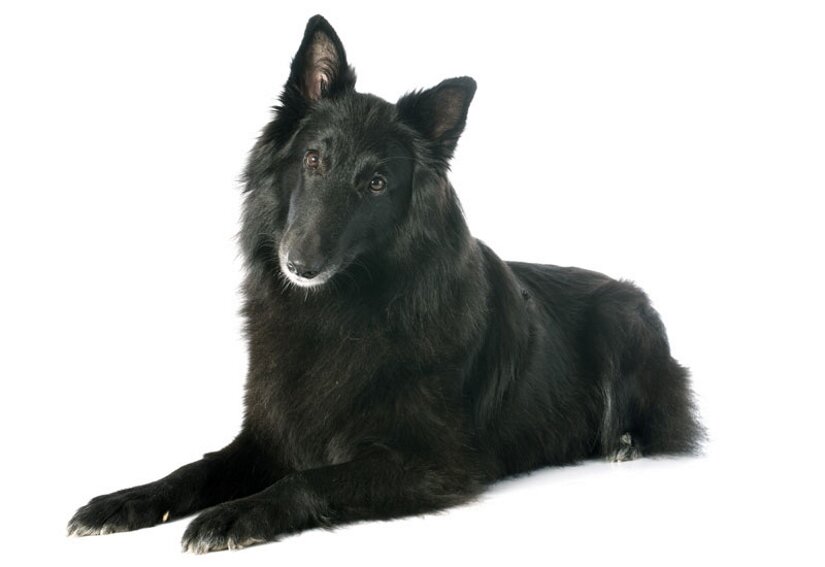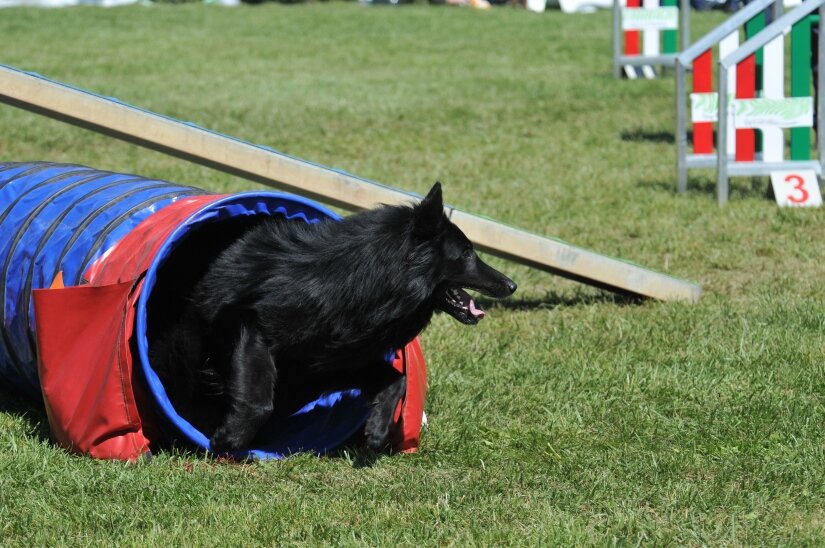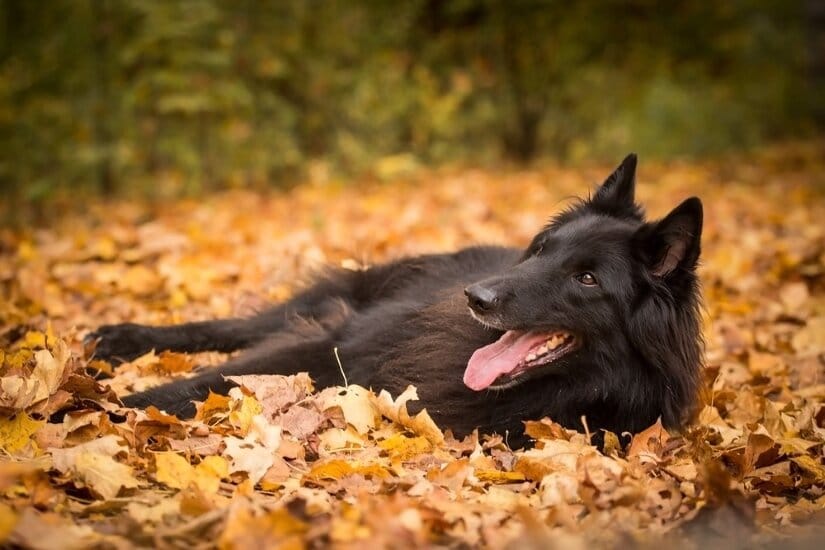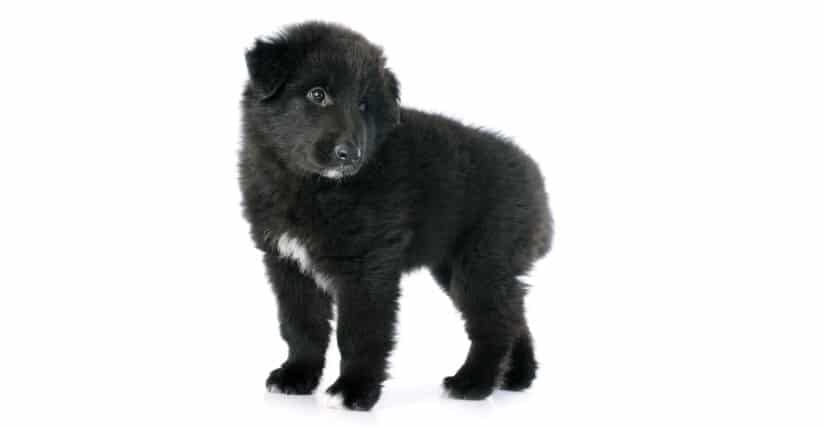



The Belgian Sheepdog is a herding dog breed from Belgium. This dog breed is one dog breed with four variations in the world. The U.S considers each type a separate dog breed. This dog breed were livestock guardians, police dogs, and were also used for military work. This dog breed was also used for messenger and draft work during World War 1.
Brief History
The Belgian Sheepdog, also known as the Chien de Berger Belge, comes from Belgium. It is part of the UKC and AKC, Herding Dog Group. Belgium at first had eight different types of Shepherd dog breeds. By 1890, only four remained. These were the Belgian Sheepdog, the Belgian Telvuren, the Belgian Malinois, and the Belgian Laekenois.
The Belgian Sheepdog was bred in Belgium during the late nineteenth century, and were used to guard and herd livestock. They were also used as police dogs, and for the military. By 1891 it was determined that all Belgian Shepherd dogs were of the same size and shape. That said, they all differed in coat length, texture, and color. All four types of Shepherds were given different names which were related to where they came from regionally. The Belgian Sheepdog Club of America was formed in 1949. Today, this breed does well showing; working as police dogs, doing search and rescue work; therapy work, and is also popular as a companion dog breed.
Physical Description
The Belgian Sheepdog is a large and muscular dog breed that is elegant and squarely built. This is a powerful and agile dog breed. With a strong head, and a pointed muzzle that is equal in length to the skull, this dog breed has large, almond-shaped eyes with large, triangular -shaped, stiff, prick ears. The gaze is intelligent and direct. This dog breed is deep- chested, and has a long black coat. The coat is slightly harsh. The undercoat is thick. The coat hair is thinner on the head, behind the ears, and on the lower legs. The coat color is black or may be black with white. This would include a small strip of white on the chest, toe tips, or chin. Males are more impressive looking than females, and are slightly larger. The neck is slightly round and outstretched. The movement is free flowing and agile. The temperament is intelligent, curious, and courageous.
Temperament

The Belgian Sheepdog is an intelligent and alert dog breed. This wonderful dog breed has a strong work drive, and is terrific with family and children. They tend to be very protective over family, and are territorial. This dog breed needs socialization from puppyhood. Positive dog training is a must since this breed is very energetic and responsive. The Belgian Sheepdog is very responsive during training, and is best as a one-person dog. They are high- energy, and are watchful and attentive. The Belgian Sheepdog is vigilant with newcomers, but not aggressive.
Special Needs
The Belgian Sheepdog needs plenty of attention and affection. This dog breed needs socialization, and positive dog training starting from puppyhood to avoid behavioral problems later on. They are very active, and can be highly strung if not trained and exercised properly. The Belgian Sheepdog needs to learn how to behave well inside and outside the home, trust strangers, and to not be overly aggressive. This dog breed cannot be left alone at home all day. The Belgian Sheepdog needs to have a scheduled day with plenty of mental stimulation and outdoor activities.
Belgian Sheepdog puppies that are well socialized, will focus properly during positive dog training classes, be less anxious in new environments, and enjoy being other dogs and people. It’s also important that your Belgian Sheepdog be introduced to children, and be allowed to play with them. Children should also learn not to disturb dogs when they are eating. All children need to be calm around dogs, and show affection and kindness. That said, with socialization and positive puppy training, your Belgian Sheepdog will learn how to live happily with people and other animals. This dog breed does well on farms, or spacey homes that have active lifestyles. This is not a dog breed for inexperienced dog parents. The Belgian Sheepdog can be exhausting during adolescence, and will need firm, kind and consistent positive dog training combined with plenty of stimulating off-leash runs, agility classes, and long hikes. This breed simply adores being with his dog parent, and having a set schedule.
Possible Health Concerns
The Belgian Sheepdog is a healthy and active dog breed that may be susceptible to the following health conditions:
- Anesthesia Sensitivity: This dog breed may have a sensitivity to anesthesia and sedation. Caution needs to be taken when considering sedation.
- Epilepsy: This is a brain disorder that is marked by sudden bursts of abnormal electrical activity in the brain. This results in recurrent seizures. Seizures that are longer than 5 minutes, or that are consecutive without full recovery necessitate immediate veterinary emergency care.
- Cancer: Mast cell cancer is common in this dog breed. Symptoms are masses that grow and shrink repeatedly. This is caused by the histamine release that results in intermittent swelling. The Belgian Sheepdog may be predisposed to osteosarcoma, lymphosarcoma, mastocytoma, melanoma, histiosarcoma, and hemangiosarcoma. Canine cancer is on the rise. Consult with your veterinarian regarding any changes in your dog. Feeding a healthy, high-quality diet starting from puppyhood is important.
- Progressive Retinal Atrophy (PRA) is the name for a group of diseases that cause degeneration of the retina. This will include inherited abnormalities of the light- sensitive cells.
- Hypothyroidism: This occurs when there are decreased levels of thyroid hormones. Symptoms include hair loss, a dull coat, flaky skin with weight gain and muscle loss. Consult with your veterinarian for advice if your dog shows any of these symptoms.
- Bloat: This breed is deep- chested, and thus more prone to bloat. Bloat is a life threatening emergency. It is caused by the twisting of the stomach, together with the accumulation of gas, with or without fluid. It is best to never elevate your dog water and food bowls. Stress is also a major factor in causing bloat. Avoid feed your dog a large meal, followed by exercise. At the first signs of dry vomiting, restlessness and discomfort, contact your emergency veterinarian. Don’t wait for a few hours. This is a true emergency that is life-threatening!
Exercise

The Belgian Sheepdog is an energetic dog breed that does well with plenty of regular exercise and canine sporting activities. Keep this dog mentally stimulated when out exercising, for mental well-being. This dog breed was bred to run long distances and herd cattle, so plenty of off-leash exercise is vital to his well-being if you don’t live on a farm.
Although this dog breed is independent, pet parents should not leave their dogs outside all day. This breed needs consistent exercise, and thrives on being with his pet parent. It is a one-person dog breed that does well with agility, herding, obedience training, tracking and Frisbee. This dog breed also enjoys regular fun family outings like playing Frisbee at the beach.
Puppy Belgian Sheepdogs under 6 months of age need to have special exercise programs especially tailored for puppyhood, so as to prevent hip dysplasia, and other injuries related to sports and exercise. Consult with your veterinarian as to the best canine sporting activities for your dog.
Nutrition
Feed your Belgian Sheepdog the best high-quality dog food that you can afford. Here are some feeding tips to follow:
- There is no “best diet”- dogs are individuals. A diet that works for one active dog breed may not be the best for another. Age, energy level and individual medical concerns play a large role for each patient.
- The recommended guidelines on bags often contain more calories than some Belgian Sheepdogs need. Check with your veterinarian for the best nutritional advice, most especially if your dog takes part in canine sports.
- Feed a complete and balanced food for the appropriate life stage of your dog.
Puppies of large-sized dogs breeds like the Belgian Sheepdog grow very fast. Rapid growth can be bad for a dog’s body, causing large-sized dog breeds to suffer from orthopedic problems like hip and elbow dysplasia at some stage in their lives. Avoid adding too many calories and calcium supplements. Some supplements may increase the growth rate of your Belgian Sheepdog puppy, causing bones to grow too fast. This results in less dense bone which are weaker, and are more prone to degenerative disease.
Overweight Belgian Sheepdogs may need to cut down on treats. Keep in mind that if your dog is not very active, and is a senior dog, it is still important to maintain muscle mass. Some senior dogs may have kidney problems. That said, they will need to have a limited protein intake every day. Today there are numerous senior-formulated dog foods for your Belgian Sheepdog that contain low protein. Consult with your veterinarian before any dietary changes, to ensure that your dog is getting the right amount of nutrients and vitamins.
All dog parents, regardless of the breed need to understand that the life stage that a dog food is marketed for, may not be the same life stage for which the food actually meets the minimum requirements. General ingredients that include whole meats, fruits or vegetables in their top five ingredients are considered good foods. Those that also incorporate antioxidants like blueberries, cranberries, pomegranates and pumpkin are also becoming popular. That said, organic, natural and preservative- free with no artificial ingredients, are also key to a well- balanced, and high quality dog food!
If you’re wanting a natural, organic and holistic dog food, dry dog food brands offer many varieties – grain free, gluten free, vegetarian and traditional. Dry dog food is available through most pet food brands. As always, your Belgian Sheepdog needs to have clean water at all times.
Look for the following when choosing a high-quality dog food for your Belgian Sheepdog:
- Healthy ingredients
- Fresh meat
- Vegetables and fruit
- No controversial ingredients
- No added hormones and steroids
- No unnamed meat sources
- Right ratio of macronutrients
- By-products in dog food are fine when they are organ meats
- Dog food should not be overly processed
- Look for glucosamine and chondroitin for hip and joint wellness for older Belgian Sheepdogs
Consulting with your veterinarian about the best options in canine nutrition is always best.
Grooming

The Belgian Sheepdog has a double- coat with a thick undercoat, and a harsher outercoat. Daily brushing is necessary to prevent matting and tangling. Bathing should be as needed depending on how active your dog is. Shedding will occur at least once a year, and there will be a lot of shedding. During shedding it’s imperative to brush twice daily to remove all the dead hair, and to keep your home hair-free. Monthly trimming is needed to trim hair on feet, head, and tail area. Fleas, ticks, and mites are some of the parasites that you will often come across if your dog is not on a flea and tick control product. That said, educate yourself as to the healthiest, non-toxic products available. Grooming needs to start during puppyhood, so that your dog will be comfortable with being handled as he gets older.
Grooming also allows for dog parents to check for lumps and tumors that may be cancerous. Wide-tooth combs are great for facial grooming. If bathing a puppy Belgian Sheepdog, fun colored dog toys will make bathing more fun. Add in some music, and reward your dog after each bath. Natural shampoos and conditioners will allow for a healthier coat. Teeth need to be brushed daily, and for dogs that don’t enjoy this, there are plenty of new canine dental products available that don’t entail brushing, and are just as effective. Nail trimming is a must, and can be done at the veterinarian or groomers. Consult with your veterinarian as to the best grooming and flea and tick meds needed for this wonderful dog breed!
Adopting a Belgian Sheepdog

This breed is an intelligent, active, and alert dog breed that may be stubborn. That said, the Belgian Sheepdog needs experienced dog parents. This is a terrific dog breed that needs to be constantly rewarded for good behavior. This dog breed is strong, and may become restless and bored without a regular exercise schedule.
The Belgian Sheepdog will adapt to home life with a sporty active new pet parent in no time, as long as he’s given plenty of daily exercise. He does well on a farm, or on property that has a large backyard. This dog breed should never be confined to apartment living. The Belgian Sheepdog learns quickly and enjoys dog training classes. This is a wonderful dog breed that needs caring pet parents that are dog experienced. Agility, tracking, herding, long runs, off-leash hikes, herding competitions and flyball are fun sporting activities for this dog breed.
As with any shelter dog, your Belgian Sheepdog rescue may have some quirks. These may include:
- House-Training lapses
- Digging
- Nipping
- Chewing
- Training issues
- Aggression though very doubtful because this breed is so gentle
- Nervousness around people depending on past history
- Food Aggression depending on past history
When adopting a senior Belgian Sheepdog, it’s best to work together with your veterinarian to determine the best ways of helping your dog with age related ailments. Twice yearly physicals are recommended. During these physicals, nutritional and exercise needs for your senior dog should be addressed. Your newly adopted dog will cherish all the pampering and love!
As usual, make sure that you have the time and resources to take good care of your rescue before adopting!
